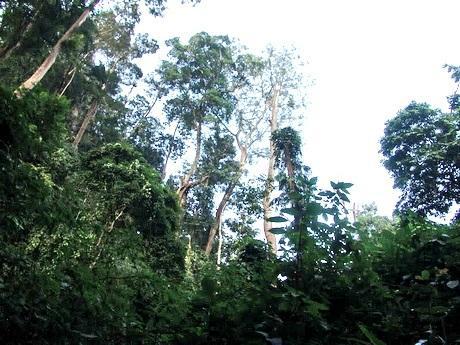Located in Thanh Son district of Phu Tho province, Xuan Son National Park possesses a diversified floristic composition with hundreds of plant and tree species, a range of wild rare animals and natural beautiful waterfalls and caves. Thanks its favorable conditions, this National Park, therefore, becomes an ideal destination of tourists in Vietnam travel.
Topography and hydrology

Xuan Son National Park- Phu Tho Province
Xuan Son National Park is located at the extreme south-eastern extent of the Hoang Lien Mountains, in the watershed of the Red River. Elevations at Xuan Son are lower than elsewhere in the Hoang Lien Mountains: the nearest point above 2,000 m is 40 km to the north-west. Limestone karst covers 1,661 ha, equivalent to 30% of the area of the national park. The limestone karst contains a large number of caves, some of which contain river systems.
Biodiversity values

The flora of the Xuan Son National Park is very rich and diverse, including 180 families, 680 genera and 1,217 species of 6 vascular plant phyla. The taxon distributions of these taxa are different. The Magnoliophyta phylum has 151 families (83.88%), 633 genera (93.08%) and 1,130 species (92.85%); the Polypodiophyta has 22 families (12.22%), 38 genera (5.58%) and 74 species (6.08%); the Pinophyta has 3 families, 4 genera and 5 species; the Lycopodiophyta has 2 families, 3 genera and 6 species; the smallest taxa are Equisetophyta and Psilotophyta with 1 family, 1 genus and 1 species each. The Euphorbiaceae is the most diverse family (60 species), followed by Rubiaceae (49 species), Fabaceae, MoraceaeThere are 26 genera with more than 5 species, made up 4% compared to the total genera of the flora but with 186 species (15.28% the total species of the flora); these genera are Ficus (24 species), Ardisia (13 species), Piper and Polygonum, each with 9 species; Diospyros, Elaeocarpus, Hedyotis. Psychotria and Dendrobium, each with 7 species; Begonia, Bauhinia, Desmodium, Maesa, Helicia, Solanum, Callicarpa, Clerodenrun, Carex, Cyperus and Dioscorea, each with 6 species and lastly Tectaria, Pteris, Schefflera, Garcinia, Rhododendron and Syzygium, each with 5 species. There are 40 endangered species (representing 3,4% of the total species of the flora of the Xuan Son national park) listed in the Red Data Book of Vietnam (2004), that need to be given priority for conservation and protection.
Useful plant resources comprise medicinal plants (665 species); timber plants (202 species); vegetables and edible fruits (132 species); ornamental plants (90 species); aromatic plants (26 species); bamboo, rattan, fern, jute (9 species); forages (12 species); floriferous plants (9 species) and poisonous plants (8 species).
Conservation aspect
The main threats to biodiversity are shifting cultivation and forest fire. These would appear to be bigger threats in non-limestone areas, where hillsides are suitable for cultivation. Communities inside the national park, which live in limestone areas, cultivate wet rice on flat valley bottoms. However, the limestone hillsides close to these communities are still covered with primary forest. One conservation issue at Xuan Son is that the national park is, perhaps, too small to support viable populations of several mammal and bird species in the long-term.
The most important tasks in Xuan Son National Park are not only preventing negative impacts on forests, protecting biodiversity and developing sources of precious genes of rare flora for high economic value, but raising public awareness and improving forest-based incomes for the locals for sustainable forest and environmental protection and management, as well.
A wide belt of land with difficult geographic characteristics and a high potential is waiting for exploration of both scientists and tourists in Vietnam travel.
(84-63) 3 826042 – (84-63) 3 511142
No 54 Nguyen Dinh Chieu, Ham Tien Central Mui Ne Beach Binh Thuan Vietnam
523 To Hien Thanh District 10 Ho Chi Minh City Vietnam
Ha Long Halong City Quang Ninh Vietnam
A13 Hung Thong 2 Halong City Quang Ninh Vietnam




